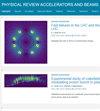Beam physics studies for a high charge and high beam quality laser-plasma accelerator
IF 1.8
3区 物理与天体物理
Q3 PHYSICS, NUCLEAR
Physical Review Accelerators and Beams
Pub Date : 2024-06-28
DOI:10.1103/physrevaccelbeams.27.063401
引用次数: 0
Abstract
Electron acceleration by laser-plasma techniques is approaching maturity and is getting ready for the construction of particle accelerators with dedicated applications. We present a general methodology showing how beam physics studies can be used to achieve a specific parameter set in a laser-plasma accelerator. Laser systems, plasma targets, and magnetic component properties are designed to optimize the electron beam so as to achieve the required performances. Beam physics in its full 6D phase space is studied from electron injection to beam delivery to the end user, through the plasma acceleration stage and transport line. As each beam parameter can only be modified by specific electric/magnetic field configurations, it is crucial to assign from the beginning specific roles to given accelerator sections in obtaining given beam parameters. These beam physics considerations were successfully applied to the design of a plasma-based electron injector for the AWAKE Run2 experiment. Electron beam parameters were calculated using a global simulation, achieving simultaneously unprecedented high charge (100 pC) and high quality (micrometric beam emittance and size).

高电荷和高光束质量激光等离子加速器的光束物理学研究
利用激光等离子体技术进行电子加速已日趋成熟,为建造专用粒子加速器做好了准备。我们介绍了一种通用方法,说明如何利用光束物理研究来实现激光等离子体加速器的特定参数设置。激光系统、等离子体靶和磁性元件特性的设计是为了优化电子束,以达到所需的性能。从电子注入到通过等离子体加速级和传输线将电子束输送到最终用户,对整个 6D 相空间的电子束物理进行了研究。由于每个电子束参数只能通过特定的电场/磁场配置来改变,因此从一开始就为特定的加速器部分分配获得特定电子束参数的特定角色至关重要。这些光束物理学考虑因素已成功应用于 AWAKE Run2 实验的等离子体电子注入器的设计。通过全局模拟计算电子束参数,同时实现了前所未有的高电荷(100 pC)和高质量(微米级电子束发射率和尺寸)。
本文章由计算机程序翻译,如有差异,请以英文原文为准。
求助全文
约1分钟内获得全文
求助全文
来源期刊

Physical Review Accelerators and Beams
Physics and Astronomy-Surfaces and Interfaces
CiteScore
3.90
自引率
23.50%
发文量
158
审稿时长
23 weeks
期刊介绍:
Physical Review Special Topics - Accelerators and Beams (PRST-AB) is a peer-reviewed, purely electronic journal, distributed without charge to readers and funded by sponsors from national and international laboratories and other partners. The articles are published by the American Physical Society under the terms of the Creative Commons Attribution 3.0 License.
It covers the full range of accelerator science and technology; subsystem and component technologies; beam dynamics; accelerator applications; and design, operation, and improvement of accelerators used in science and industry. This includes accelerators for high-energy and nuclear physics, synchrotron-radiation production, spallation neutron sources, medical therapy, and intense-beam applications.
 求助内容:
求助内容: 应助结果提醒方式:
应助结果提醒方式:


